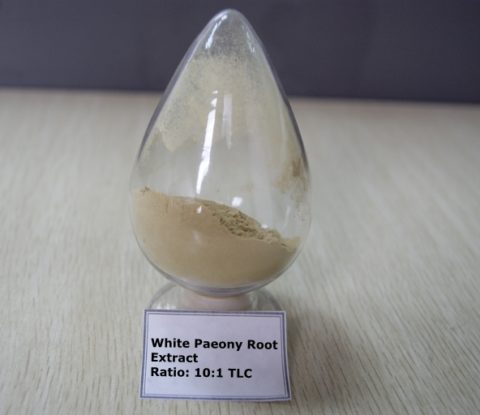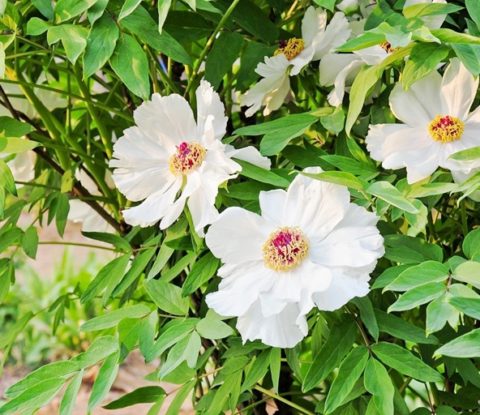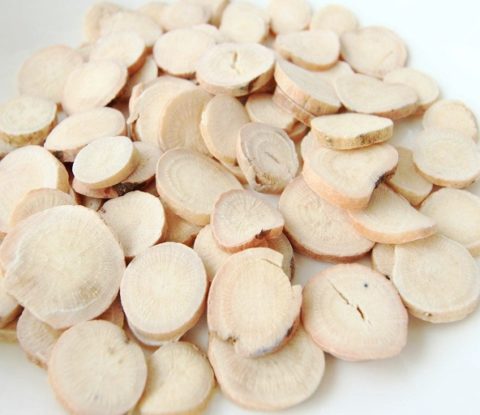
White Paeony Root Extract
【Botanical source】: Paeonia lactifloria Pall
【Part used】: Root
【Specification】:
Standard extract: Paeoniflorin 10%-98% HPLC
Ratio extract: 10:1, 20:1 by TLC
【Appearance]: Brown to light brownish fine powder
【Particle size】: 95% pass 80 mesh
【Active ingredients】: Paeoniflorin(CAS No: 23180-57-6)
【Molecular formula】: C23H28O11
【Molecular weight】: 480.45
【Benefits】: pain-relieving and restores Immunity
Brief Introduction
The peony flower grows wild in China, where it is called “Shao Yao” for “most beautiful,” and comes in a variety of colors ranging from light pink to dark maroon. It is also cultivated as an ornamental plant throughout the world. Peony is named for the mythical Greek figure Paeon, who was said to be a student of the illustrious physician Aesculapius. Peony root has been used as a diuretic, sedative, and tonic, and is known for its antispasmodic, analgesic, and anti-inflammatory effects. The ancient Greeks used it to treat epilepsy and promote menstruation. European herbalists used the root as an antispasmodic and to soothe nerves.
Additionally, different color flowers were used for different ailments. In Chinese medicine, Bai shao or white peony was used to treat hypertension, chest pain, muscle cramping and spasms, and fever. Chi shao or red peony was used for various conditions pertaining to blood, such as bleeding or restricted blood flow, nosebleeds, bleeding wounds, and excessive menstrual bleeding. It was also used to treat female problems including painful and irregular menstruation. In fact, in Traditional Chinese Medicine, it is one of the most widely used herbs to treat menstrual cramps and menstrual irregularities.
Active Constituents
Chinese scientists recently discovered three new glycosides in peony, including a unique monoterpenoid glycoside called paeoniflorin, which calms nerves and alleviates muscle spasm. Even more exciting is the Japanese discovery of paeoniflorin’s ability to improve memory in animal studies, suggesting a potential benefit for dementia. Paeoniflorin, proanthocyanidins, and flavonoids have also demonstrated antioxidant activity in test tubes. Additionally, polysaccharides found in peony bark and roots have shown an ability to stimulate the immune system.
Paeoniflorin has also been shown to account for many of the pain-relieving properties of peony glucosides. Studies of experimentally-induced arthritis in rats demonstrate reduced swelling and scar tissue in joints, along with decreases in bone and cartilage destruction; together, all of these factors affect how much pain people feel from their arthritis(Zhang W, Dai SM. Mechanisms involved in the therapeutic effects of Paeonia lactiflora Pallas in rheumatoid arthritis. International immunopharmacology. Sep 2012;14(1):27-31.).
In laboratory mice with excessive inflammation (for example, those with arthritis or psoriasis), peony glucosides inhibited over-active immune reactions, resulting in reduced cytokines and overall inflammation(He DY, Dai SM. Anti-inflammatory and immunomodulatory effects of Paeonia lactiflora pall., a traditional chinese herbal medicine. Front Pharmacol. 2011;2:10.). But in animals whose immune system is suppressed (similar to people treated with steroids, having chemotherapy, or with immune-impairing diseases such as HIV/AIDS), peony glucosides enhanced the immune response, bringing antibodies and immune system attack cells back up. Translated into human terms, this implies that people with overactive immune systems, such as those with lupus and other autoimmune diseases, would benefit from the immune-suppressing effects of peony glucosides. At the same time, those with suppressed immune systems would see fewer serious infections and a lower cancer rate.
Peony glucosides achieve this immune balance by a variety of subtle mechanisms that include slowing the maturation of cells that promote immune responses while boosting maturation of the regulatory cells that return the immune system to its normal, neutral state(Chen JY, Wu HX, Chen Y, et al. Paeoniflorin inhibits proliferation of fibroblast-like synoviocytes through suppressing G-protein-coupled receptor kinase 2. Planta medica. May 2012;78(7):665-71.). This level of immune balancing is beyond what current medications can do (medications typically either boost or suppress immunity, not both at the same time). The result of this balancing act is likely to be a substantial reduction in symptoms and flare-ups of both autoimmune diseases and their counterparts, infections and cancers in people with under-active immunity.
This dual action immune balancing extends all the way to target tissues. For example, in rheumatoid arthritis, over-active joint-lining cells create a hyperinflammatory response in the joint, producing pain and destruction of the joint surfaces. Peony glucosides prevent those cells from becoming over-stimulated, sparing the joint from autoimmune damage and reducing joint pain and swelling. Unlike mainstream medications that aim only to shut down the inflammatory response, peony glucosides are a true immunomodulator, which rebalances the disordered immune response and enables the body to restore its own equilibrium.
Benefits of White Peony Root Extract in Modern Researches
Autoimmune Arthritis
In China, peony glucosides are an approved drug for treatment of rheumatoid arthritis, the most common autoimmune arthritis. In laboratory experiments, animals with rheumatoid arthritis develop increased numbers of inflammatory cells. These cells then produce high levels of inflammatory cytokines resulting in destructive inflammation of the delicate tissues lining the joints. The end result is destruction of the joint. Supplementation with peony glucosides appears to reduce the population of inflammation-provoking cells while increasing the inflammation-suppressing ones(Wu H, Wei W, Song L, Zhang L, Chen Y, Hu X. Paeoniflorin induced immune tolerance of mesenteric lymph node lymphocytes via enhancing beta 2-adrenergic receptor desensitization in rats with adjuvant arthritis. Int Immunopharmacol. 2007 May;7(5):662-73.). The result is that inflammatory cytokine levels fall while the over-active immune response in the joints begins to reverse; animal studies show that this biochemical reversal of inflammation is accompanied by reversal in joint damage and pain(Lin J, Xiao L, Ouyang G, et al. Total glucosides of paeony inhibits Th1/Th17 cells via decreasing dendritic cells activation in rheumatoid arthritis. Cell Immunol. 2012 Dec;280(2):156-63.).
Treatment with peony glucosides produces a significant reduction in both arthritis severity and joint damage. Studies in animals with experimentally-induced arthritis, for example, demonstrate a reduction in clinical manifestations of arthritis after treatment with peony glucosides(Xu HM, Wei W, Jia XY, Chang Y, Zhang L. Effects and mechanisms of total glucosides of paeony on adjuvant arthritis in rats.J Ethnopharmacol. 2007 Feb 12;109(3):442-8.). Arthritis scores, numerical summaries of joint swelling, range of movement, and other parameters are lower in supplemented animals than in controls. Finally, autopsy results of these experimental animals reveal significant reductions in visible joint damage of the kind that produces pain and immobility in human sufferers(Zhang W, Dai SM. Mechanisms involved in the therapeutic effects of Paeonia lactiflora Pallas in rheumatoid arthritis. International immunopharmacology. Sep 2012;14(1):27-31.).
Protects Against Memory Loss and Supports Liver Function
One of the most amazing findings in the research into how peony has so many beneficial properties was the discovery that paeoniflorin, the unique phytochemical found in peony, has the ability to increase Heat Shock Protein production.
Even more impressive, paeoniflorin not only increased Heat Shock Protein levels in unstressed cells, but also dramatically enhanced the cells ability to increase Heat Shock Protein production when faced with stress. Heat Shock Proteins are believed to play a major role in many diseases. The recent discovery that paeoniflorin can enhance one of our bodies most important protective mechanisms should broaden peony and paeoniflorin’s potential to be useful in a wide variety of diseases, and even the aging process itself. Although peony has not yet been studied in human clinical trials, numerous recent animal studies indicate that it may be beneficial in the fight against dementia:
1). Exerts a protective effect on animals with cerebral ischemia (stroke).
2).Helps animals recover more quickly from stroke.
3).Stimulates the hippocampus—which is in the brain’s temporal lobe, and is responsible for storing new information—in memory-impaired rodents, to enhance learning and memory. This is significant because in humans Alzheimer’s disease and other forms of dementia affect the hippocampus first, before other parts of the brain.
4).Ameliorates spatial cognitive impairment in animals given an amnesia-producing drug.
5).Exerts a protective effect on brain neurons in animals during epileptic seizures.
6).Improves the ability to learn in animals with age-related learning deficits. The scientists concluded that peony has the therapeutic potential to treat senile dementia and aging-induced cognitive dysfunction.
Indications in Traditional Chinese Medicine
Blood deficiency syndrome
It is a common herb applied for regulating menstruation, and it is very indicated for irregular menstruation of blood deficiency with heat type because it is cool in property and skilled in clearing deficiency heat in blood system. For irregular menstruation of blood deficiency with heat type, it is combined with blood-nourishing and heat-clearing herbs, for instance, Si Wu Tang add Huang Lian, Huang Qin is Qin Lian Si Wu Tang from Yi Zong Jin Jian. For irregular menstruation of blood deficiency with liver depression type, it is combined with liver-soothing and blood-nourishing herbs, for instance, it is used with Chai Hu and Dang Gui in Xiao Yao San from Tai Ping Hui Min He Ji Ju Fang. For metrorrhagia and metrostaxis in dark-red color, annoyed heat in chest due to yin deficiency with effulgent heat, it is combined with yin-nourishing and heat-clearing herbs, for instance, it is used with Gui Jia, Huang Qin, Huang Bo in Gu Jing Wan from Yi Xue Ru Men.
Sweating due to deficiency
It can astringe yin to check sweating. For night sweat due to yin deficiency, it is combined with yin-nourishing and sweating-checking herbs, such as Sheng Di Huang, Mu Li. For spontaneous sweating due to superficial deficiency caused by disharmony of Yin and defensive system, for instance, it is used with Gui Zhi in Gui Zhi Tang from Shang Han Lun.
Hypochondriac pain, abdominal pain and muscular contracture pain of four limbs
This herb is expert to alleviate pain by emolliating liver and it’s a commonly used herb for those above-mentioned pains due to liver-blood deficiency and tendon dystrophy. It’s often applied with Gan Cao as mutual reinforcement, such as in Shao Yao Gan Cao Tang from Shang Han Lun. The modification of this formula is often used to treat contracture occurring during the process of many diseases.
Syndrome of Hyperactivity of liver-yang
This herb can subdue liver yang and clear liver heat. It’s applied to treat dizziness and vertigo, flushed face and conjunctive congestion, irritability, the problems caused by hyperactivity. It is often combined with herbs which can subdue hyperactive liver yang and clear heat and replenish yin. For example, as Jian Ling Tang recorded in Yi Xue Zhong Zhong Can Xi Lu, it is used together with Dai Zhe Shi, Sheng Di Huang, etc.






